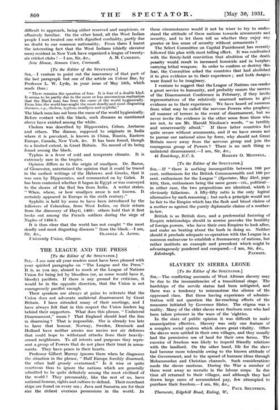[To the Editor of the SPECTATOR.] SIR,—I venture to point
out the inaccuracy of that part of the last paragraph but one of the article on Colour Bar, by Professor L. W. Lyde, in your issue of May 16th, which reads thus : " There remains the question of fear. It is fear of a double kind. It seems to be partly due to the more or less unconscious realization that the Black man has been the curse of the world hygienically. From him the world has caught the most deadly and most disgusting diseases, e.g., cholera, typhus, smallpox and syphilis."
The black man has not been the curse of the world hygienically. Before contact with the black, such diseases as mentioned above have existed among the white.
Cholera was described by Hippocrates, Celsus, Aretaeus and others. The disease, supposed to originate in India where it is prevalent, is known in China, Russia, Eastern Europe, Canada, New York, &c. It has been found, though to a limited extent, in Great Britain. No record of its being found among the black.
Typhus is a fever of cold and temperate climate. It is extremely rare in the tropics.
Opinion differs as to the origin of smallpox. Dr. Baron, of Gloucester, entertained the opinion that it could be traced in the earliest writings of the Hebrews and Greeks, that it was seen by Hippocrates, and commented on by Galen. It has been contested whether it began in Egypt or was conveyed to the shores of the Red Sea from India. A writer states, " When, where, or how smallpox arose is not known. It certainly appeared in Europe in the sixth century."
Syphilis is held by some to have been introduced by the followers of Columbus, from West Indies, on their return from the discovery of Hayti, 1493: others hold that it first broke out among the French soldiers during the siege of Naples of 1494-5. - - - It is thus clear that the world has not caught " the most deadly and most disgusting diseases " from the black.—I am, University Union, Glasgow.






































 Previous page
Previous page